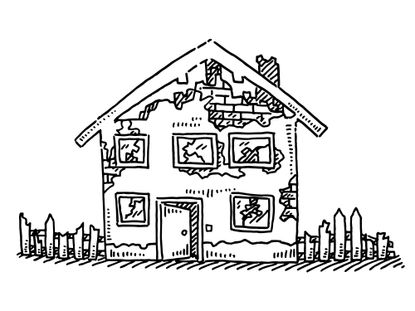Subsidence: how to spot it and how to solve it
Subsidence, the word every homeowner dreads to hear — but it need not spell disaster. Our guide covers everything, from causes to what it may cost to rectify

Although a subsidence is certainly not something you want to find in your property, it is surprisingly common and doesn’t always mean you can’t get home insurance, cause irreparable damage, entail a huge amount of disruption or result in crippling financial outlay.
It is also worth noting that cracks and movement in a house are often misdiagnosed as subsidence when there is actually something else that has caused them. In fact, a great many insurance claims for subsidence turn out to simply be cosmetic damage, caused by movement after an extension or alteration for example.
Our guide to subsidence will explain everything you need to know to ensure that, should you find yourself dealing with this issue, you are fully equipped with all the knowledge required.
What is subsidence?
Subsidence in houses is when the ground underneath the building sinks — or subsides. Due to the ground moving, the foundations move and, as the ground sinks and moves, cracks appear and the stability of the building is compromised.
It is important not to confuse subsidence with heave or settlements. Heave occurs when the ground beneath the house moves upwards, and settlement happens when the earth beneath becomes compressed under the weight of the house, causing the whole thing to shift downwards — this usually happens within 10 years of a property being built. It can be extremely difficult to get house insurance on a house with settlement.
Subsidence is also different from a landslide as this is when the ground moves down a slope or becomes washed away.
What causes subsidence?
There are several causes of subsidence. Sometimes, the ground under a section of the foundations will shrink meaning there is no support for the wall above that part. Common culprits include large tree roots sapping moisture from the ground, particularly in periods of drought. It has been estimated that around 70% of subsidence cases are caused by tree roots.
Look After My Bills Newsletter
Get the best money-saving tips, tricks and deals sent straight to your inbox every week. Make sense of your money in partnership with The Money Edit.
Another common cause is soil type — clay is particularly prone to shrinking, cracking and moving in long dry periods.
Leaking drains or water mains can also lead to subsidence, weakening the soil so that it sinks.
Shallow foundations can also be a contributing factor — older properties were often built with shallow foundations although their construction of masonry and lime mortar often deals well with movement.
Finally, homes built close to old quarries or in mining areas can suffer from subsidence — subsidence claims reports are available from the local authority.
Whatever has caused the subsidence though, the most important thing to ascertain, and certainly the thing that will affect your ability to get home insurance, will be whether the movement is ‘historic’ or ‘progressive’ — meaning has the subsidence now stopped or is it still likely to cause further damage?
Signs of subsidence
Cracks are not always a sign of subsidence. However, certain types of crack can point towards trouble. These include cracks that are:
- Wider than 3mm
- Running diagonally
- Wider at the top than the bottom
- Visible internally and externally
- Near doors or windows
Other signs of subsidence can include:
- Doors or windows that stick in their frames
- Wallpaper that has rippled at the joints
- Very uneven floors
How is subsidence fixed?
Depending on the cause of subsidence, it might be quite easy to stop it in its tracks and, contrary to popular belief, underpinning is not always necessary.
If it is discovered that the subsidence is being caused by tree roots nearby, the tree can be removed — something that should only be done in consultation with a surveyor and a tree surgeon.
If leaks in pipework have been identified as the cause these should be fixed before checking that the property has stabilised.
Underpinning should only be undertaken as a final resort — it is expensive and disruptive and often unnecessary. In fact, according to the Royal Institution of Chartered Surveyors (RICS) fewer than 10% of properties with subsidence need to be underpinned.
How much does it cost to fix subsidence?
This depends on the cause, but, according to data from the Association of British Insurers, the average payout for subsidence is £6,250. However, should underpinning be required, costs can run to tens of thousands, although a more typical cost for underpinning the average house would be around £10,000 to £15,000.
Subsidence and house insurance
It is still possible to get home insurance on a house that has suffered from subsidence, although most insurance companies will want to monitor and measure the movement over at least 12 months in order to try to predict the risk of future movement.
Most house insurance policies do cover subsidence but only when a house has not suffered from it in the past. Look for policies that cover repairs to damage caused by subsidence, alternative accommodation and lost or damaged items.
Houses that might be particularly prone to subsidence, such as those in coastal areas, can benefit from specialist insurance.
-
 Three energy firms pay £8m in switching compensation - has your provider paid out?
Three energy firms pay £8m in switching compensation - has your provider paid out?More than 100,000 customers have received compensation after changing providers, but is now a good time to switch energy suppliers?
By Tom Higgins Published
-
 Save £300 on your supermarket shop with cashback accounts
Save £300 on your supermarket shop with cashback accountsBanks, credit card companies and cashback sites are all offering cashback on your supermarket shop, but can you use them all to max out your savings?
By Vaishali Varu Published
-
 Travel insurance: what to look for when buying travel cover this Easter
Travel insurance: what to look for when buying travel cover this EasterBuying travel insurance can seem like one more job on your holiday ‘to do’ list, but it’s important you don’t leave home without it. We explain what to look for when shopping around for the best deal
By Sue Hayward Published
-
 Missed flight cover: when can you claim if you miss your plane?
Missed flight cover: when can you claim if you miss your plane?Bad weather, traffic jams, breaking down or not having a valid passport could all mean you can’t get as far as the airport – we look at whether your travel insurance will pay up
By Sue Hayward Published
-
 Six reasons your home insurance could be refused, cancelled or voided
Six reasons your home insurance could be refused, cancelled or voidedCheck your policy and read the small print to ensure your home insurance is not refused, cancelled or voided
By Sue Hayward Last updated
-
 Average price paid for home insurance ‘at lowest levels in at least a decade’
Average price paid for home insurance ‘at lowest levels in at least a decade’The average cost of home insurance in 2022 was £300 - how does your premium compare?
By Katie Binns Published
-
 Revealed: the job titles that add £100s to car insurance - and the cheaper alternatives
Revealed: the job titles that add £100s to car insurance - and the cheaper alternativesJob titles that will see the biggest rise in car insurance costs in 2023 have been revealed - is your job title one of them? And how to find cheaper alternatives
By Vaishali Varu Published
-
 How to avoid sneaky car insurance fees
How to avoid sneaky car insurance feesSome motor insurers are increasing fees and charges for motorists. We reveal how to avoid them
By Sue Hayward Last updated
-
 How to get cheap car insurance: 10 ways to cut the cost
How to get cheap car insurance: 10 ways to cut the costIf you’re a driver, you can’t hide from paying for car insurance but knowing how to get cheap car insurance can cut the cost without compromising cover quality.
By Vaishali Varu Published
-
 Amazon sells insurance: is comparing and buying an insurance policy through Amazon any good?
Amazon sells insurance: is comparing and buying an insurance policy through Amazon any good?Amazon Insurance Store launches in the UK to sell home insurance
By Sue Hayward Published